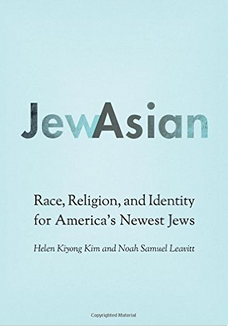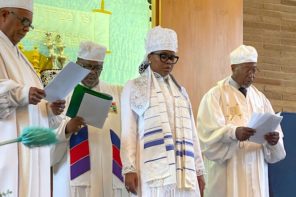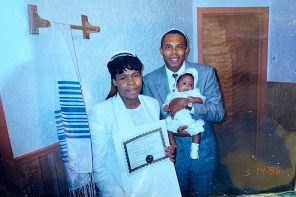A new book from married co-authors, Helen Kiyong Kim and Noah Samuel Leavitt, explores the intricacies of mixed partnerships and blended heritages.
What inspired you to write JewAsian?
Originally, it was a combination of wondering whether our particular relationship fit into any larger social trends about mixed partnerships and then not finding anything in the academic literature that could answer that question. (We were grad students in a social science master’s program at the University of Chicago when we started dating.) When we got around to actually designing the research project we were about to become first-time parents, and we wanted to know if there was anything we needed to be aware of to raise our kids!
What’s the most important take-home message for readers?
Families that combine Jewish and Asian heritages create homes marked by strong Jewish identity and also create mixed race children who are active and confident in their Judaism despite doubts from many people around them. Or, in a more generalized way, don’t make assumptions about anyone you meet since they are very likely not at all like what you think they are like.
JewAsian: Race, Religion, and Identity for America’s Newest Jews
Helen Kiyong Kim and Noah Samuel Leavitt
University of Nebraska Press
July 2016
Is there anything you had to leave out?
We were fortunate to be able to include nearly everything for which we had strong and reliable data. Originally, we had thought that we would explore the civic and political engagement among JewAsian couples, but ultimately we weren’t able to sustain those questions through all of our interviews—largely because our interviewees wanted to talk about many other aspects of their lives! Having said that, many of the millennial grown children of JewAsian families told us about their political involvements without being prompted, and so we did include those responses.
What are some of the biggest misconceptions about your topic?
Many people—including the two of us at the beginning of this project and largely as a result of what we had read in the sociological literature on Jewish intermarriage—thought that households that combined such seemingly different traditions would not only be filled with conflict but also a diminishing of Jewish religiosity. However, they would be—and we certainly were—wrong on all of those points!
Next, most people would think that most of the Jewish and Asian couples we spoke with were the stereotype of a white Ashkenazi Jewish man and an Asian/Asian-American woman, but when we initially reached out across the country for possible interviewees the more than 200 surveys we received were split almost evenly on gender lines. We weren’t expecting that!
Finally, we also know that many people think that these households work because of a shared love of Chinese food (on Christmas or otherwise), which we know is true, but is only a tiny part of what makes these families work.
Did you have a specific audience in mind when writing?
Thinking through this question in detail before we started on the manuscript really helped us make key decisions about our writing style and voice. As faculty and staff at a wonderful small liberal arts college with lots of students who are mixed (in many ways) we wrote this book to let those young people read about households that also combined different traditions and heritages and customs. Of course we wrote for our fellow academics and so we worked from the literature and triple check all of our methodological steps.
Next, we’ve been really impressed with efforts in the American Jewish community to be aware of and enthusiastic about its growing racial diversity and so we wrote this for Jews to better understand some of our families and perhaps congregation members. We also wrote it for anyone interested in American growing percentage of mixed households of all kinds of racial, ethnic and religious mixes, including but not limited to the JewAsian mix. Finally, we wrote it for our now 8 and 5 year old son and daughter (and we also dedicated the book to them, which they’re really proud of).
We were so fortunate to work with University of Nebraska Press, which when we entered into contract discussions had recently acquired the entire catalogue of the venerated Jewish Publication Society and therefore had the talent and brand recognition to offer an audience that mixed academic readers and popular readers. Perfect.
Are you hoping to just inform readers? Entertain them? Piss them off?
We definitely want to inform our readers and help them gain a rich understanding of how family dynamics can work. We want readers to see that traditions and heritages may or may not carry through to the next generation and to understand
We imagine we might piss off people who believe in a coming nightmarish “mongrelization” of society but we didn’t specifically write with that terribly worrisome potential audience.
Also, early in the book we talk about some of the internet chatter after the wedding of Mark Zuckerberg (Jewish) and Dr. Priscilla Chan (Asian-American, religious identity unknown) and there were definitely some voices out there critical of that “outmarriage” that would probably not know what do with our finding that households like theirs generate strong Jewish practice. Maybe we’d say that we were “confusing” to them.
What alternative title would you give the book?
We loved that our interviewees shared with us a full bag of neologisms that they used to capture their many combined and interacting identities. During our research we heard Jewpanese, Kojew, Hinjew, JewBu and other linguistic innovations. Ultimately, we felt “JewAsian” best captured the widest range of Asian and Asian-American backgrounds of the people we met.
How do you feel about the cover?
We’ve treasured our interaction with the team at Nebraska Press, and we imagine that they’ve been quite amused by some of our questions and worries as first-time authors. Their design team was amazing about getting input from us early on about a range of elements about which they wanted to hear our preferences. When they sent us the mock-up one of us wondered whether the shading on the word “JewAsian” accurately depicted the interaction of those different identities within the households we learned about. When we raised this with our contacts, they very politely and kindly told us that a book cover is supposed to get a potential reader’s attention, not embody the findings of the writing! That was a helpful lesson, and we’ve been thrilled with what they did.
Is there a book out there you wish you had written? Which one? Why?
Some books were living in the back of our minds as we were working on JewAsian, all of which would have been wonderful to write.
What’s your next book?
We wish there was a way that we could convey how much time we’ve spent on this exact question this summer. We have a desire to extend this project in one of several ways. We could: revisit the families we interviewed in five years and see what they think of the questions we asked them for JewAsian, do an international comparative study of JewAsian households in a variety of countries (the U.S., England, Israel, and Japan are on the top of that list), or look at other racially-mixed Jewish households inside the US in a similar way (Jewtino? Jewskimo?).






